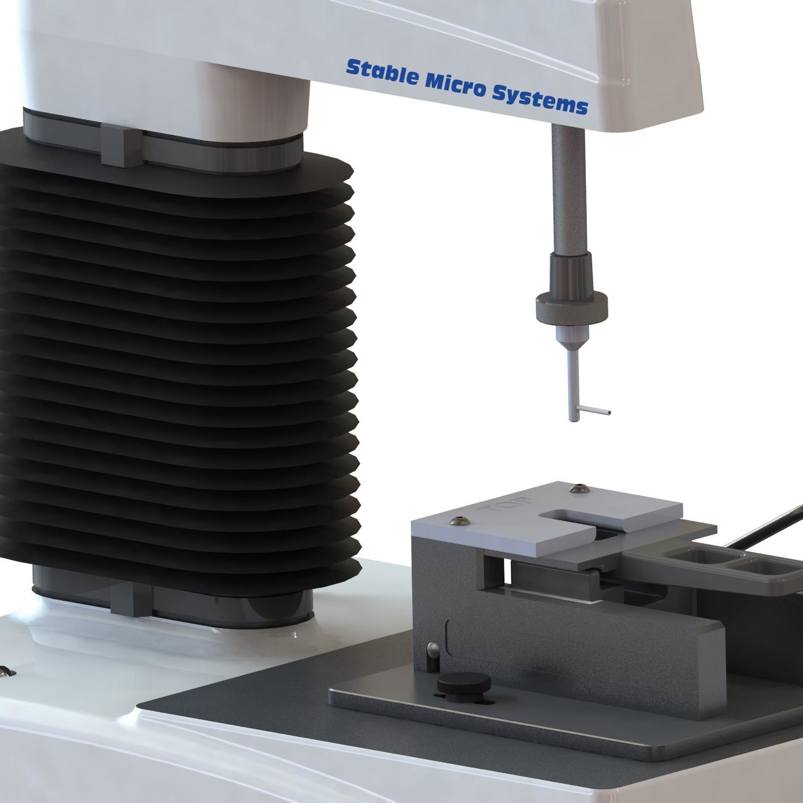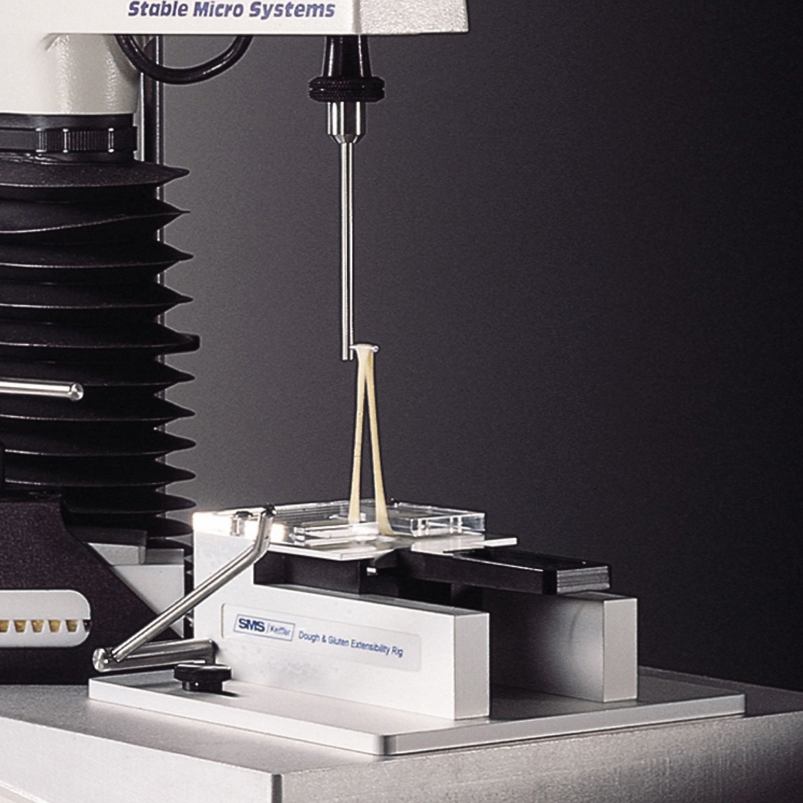Product overview
The rheological properties of a dough play important roles during several processing steps after mixing. As a dough piece is divided and rounded, the balance of its viscoelastic properties is critical. A dough that is too viscous flows too much during this step and does not maintain the desired final shape. If the elastic component is too dominant (often termed a bucky dough), it is difficult to round into the desired shape and hence the final product does not have the desired shape.
A correct balance of viscoelastic properties is also important during the sheeting and moulding steps. If a dough is too extensible (its viscous component too dominant), the result is a piece of dough that is too long for the moulding step. If the elastic component is excessive (bucky), the dough springs back too far after sheeting and produces a piece that is too short to fill the pan completely.
Extensibility and extensibility resistance of wheat doughs are readily accessible physical measurable quantities which allow good assessment of the baking behaviour under realistic conditions. Such methods have therefore established globally as AACC/ICC standard methods. However, the disadvantage of these methods is that substantial quantities of material are required and that they are time-consuming; for example, up to 300g of flour are required for a duplicate test. It is this large amount of material, in particular, which is a limiting factor in many fields of activities, for example in research, in the development of dough additives and, especially in plant breeding, where it is desirable that the processing qualities of new breeding material can be determined in as early a generation as possible.
This microextension rig was developed at the Kurt Hess Institute in Munich by Dr. Kieffer as an improvement to the extensibility measurements provided by the Brabender Extensograph. The rig comprises a dough sample preparation press and mould, a spring-loaded test rig and a test hook. A prepared sample (10g of flour can be used for six replications) from the preparation press is securely located in the rig so that the hook, positioned underneath, can move vertically through it. The maximum force and distance to break (extension) are measured.
Parallel tests of dough and gluten can reveal particular characteristics arising from homogenisation, long relaxation times or from adding oxidants, salts, emulsifiers or enzymes. Only small samples are required (approx. 10g flour or 1-2g gluten) which is of particular interest to wheat breeders requiring information of rheological qualities at an early stage for the development of hybrids. It has been demonstrated that results obtained in microextension trials can provide the same information as the macromethods.
In practice, determination of the quality of gluten (which governs the unique viscoelastic characteristics of wheat dough) was previously done by simply extending the gluten (which had been washed out of the dough) between the fingers. A grave disadvantage of all experiments aimed at making this test more objective is that the data obtained cannot be compared directly with the graphic results obtained in dough extension trials since they are based on quite different principles of measuring. A direct comparison of dough and gluten is now offered by the Kieffer Dough and Gluten Extensibility Rig and is frequently very useful for interpreting changes measured in dough. For example, it is possible to unveil artefacts which may arise from homogenisation, long relaxation times or from adding oxidants, which make the doughs drier. Microextension trials with dough and gluten, carried out in parallel, are furthermore useful for selecting suitable dough additives, such as salts, emulsifiers, oxidants or enzymes. The forces required for extending, which can be very small, such as in the case of soft doughs, can be determined accurately using the Texture Analyser.
How does the Kieffer Dough and Gluten Extensibility Rig work?
Ideal sample form
A semi-solid or solid extensible material which can be gripped horizontally at its ends in order to pull vertically upwards in its central region with a hook.
Benefits and limitations
- Has also been used to assess the tensile properties of chewing gum and liquorice.
- The spring-loaded clamp mechanism can be adjusted to modify the gripping pressure.
- If used for testing samples other than dough a thicker hook may need to be used to avoid bending.
Optional extras
Spare Dough Moulding Form and Press – A/FOR
5 Hook Sleeves, Spatula and 500 Lametta strips – A/KIC
Kieffer Dough Moulding Former – A/KDMF
Spare Kieffer Hook – A/KIE-DH
Technical information
Installation
Full installation instructions are provided within the Education Zone of the latest Exponent/Connect software version and on the technical information sheet accompanying this product.
Chemical compatibility
Stable Micro Systems probes and attachments are commonly made from four materials: anodised aluminium (AA6082 T6), stainless steel (316 T), Delrin (acetyl copolymer) and Perspex (polycarbonate).
In general use, probes and attachments made from these materials will be suitable for testing food products and inert non-food materials.
The four materials listed above are not universally resistant to all types of chemicals and as such the compatibility of the probe/attachment material with the product (to be tested) must be established to prevent damage to the probes and attachments. If the compatibility of the product with the probe is unknown to the customer then the chemical information about the product (Material Safety Data Sheet or Product Data Sheet) should be submitted to Stable Micro Systems. Stable Micro Systems will then assess the suitability of the probe/attachment material for use with the product and advise accordingly. If this advice is not sought then Stable Micro Systems will not accept liability for probes/attachments damaged by chemical attack from the product being tested.
Cleaning and maintenance
All probes and attachments may be cleaned in warm (or hand hot) water using a mild detergent. A soft brush may be used but abrasive cleaning aids should be avoided. Stable Micro Systems products should not be microwaved or cleaned in a dishwasher.
Screw threads should be lightly lubricated after drying using a light lubricant, e.g. petroleum jelly, mineral oil. This will aid the fitting and unscrewing of the item. Each component of a probe or attachment should be wrapped separately when stored, to avoid scratching or chipping. This will safeguard against any unnecessary damage to the accessory.
Troubleshooting
If the rig is situated too far forward the hook touches the perspex top as it moves through.
If the test starts with the hook touching the spring-loaded platform there will be a force offset created.



